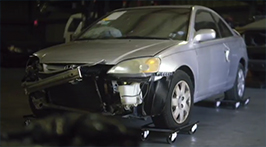Hydraulic presses are used as a type of automated levering and lifting system on construction sites. The hydraulic systems are a means of moving or providing powering force for construction work. Hydraulic systems may be used for lifts or for various tasks including pressing, riveting, stamping, and punching. They are often used to help form and shape metal, plastics, car parts, and fiber glass.
Hydraulic press systems are typically filled with fluid which is moved to create pressure, although some systems are built on pressurized air. They also require a firmly closed circuit in order to maintain an even amount of exerted force. Where the system is compromised, lifting and moving abilities suffer. In some cases, the system compromise can also result in the internal fluid of the press shooting outward at users and other equipment pieces. Despite the added safety features, hydraulic presses can be very dangerous to be around.
Specific Weaknesses of Hydraulic Press Systems
Hydraulic press systems rely on a closed system and a pure internal liquid or gas in order to operate smoothly. Their main weakness lies in any contamination of the internal fluid or gas. A secondary malfunction area comes when the system is unable to remain closed.
Typically, the internal liquid (often oil based) is highly pressurized. This puts considerable outward pressure on the systems, and any weakness in joints, hoses, or pressure release points can lead to system failure. Additionally, any contamination in the internal fluid can cause clogs and jams, leading to over pressurization or system failure.
Dangers of Hydraulic Presses
Hydraulic presses are not normally fully automated, which makes it more dangerous. The presses use hydraulic oil to run, making the floor very slippery if there are any leaks from hoses or connections. In some cases, it may take more than one operator to properly work a hydraulic press. A person can easily injure a hand or other body part during the cycling of the machine, and just about every step of the manufacturing process can be hazardous to people who are working with or near hydraulic presses.
Operators risk sustaining severe bodily injuries from punch presses and other auxiliary equipment, as well as severe lacerations from feeding sharp-edged materials into the stock straightener. Strangulation is possible if they have long hair, loose clothing, or wear jewelry.
According to the Occupational Safety and Health Administration (OSHA), a common reason for numerous injuries is the lack of proper machine guards. OSHA also indicated that many operators or employers intentionally remove some of the safety features. OSHA highly recommends that barrier guards, two-hand tripping devices, and electronic safety devices be provided and utilized to protect the operator and other employees.
Injuries Causes By Hydraulic Presses
According to the Bureau of Labor Statistics (BLS), approximately three-fifths of all work-related amputations involved a worker operating a piece of machinery such as a press or conveyer. This report stated that the worker’s finger or arm got caught or compressed by the machine. OSHA estimated that 49 percent of the injuries from mechanical power presses resulted in amputation.
OSHA tracks injuries related to hydraulic presses and divides those injuries into several categories, including injection injuries, exposure to toxicity, burns, and injuries caused by other material movement.
Injection injuries are caused when the liquid or gas that is inside the hydraulic press explodes out from the machine. Propelled by extreme force, it pierces the skin and underlying tissues. This can cause material from the injury to be embedded deep within the body, with the gelatinous nature of the material making it difficult to clean or disinfect the wound. Men between the ages of 21 and 59 are the most highly impacted by this kind of injury.
Exposure to toxicity is also a possible injury. Even in hydraulic presses powered by air, the internal system is often using a gas very different than pure air. Exposure to fumes and liquids from inside a broken hydraulic press can sicken workers. Even leaks as small as a pinhole can drive fumes and toxic liquid out at pressures of more than 600 pounds per square inch.
Burns are a common outcome of hydraulic press failure. Due to the high pressure levels, the internal material is quite hot. Even when injection injuries do not occur, surface skin damage is possible due to burns.
Injuries caused by other materials generally are caused by the hydraulic press failure leading to whipping hoses or flying parts. These items will be suddenly loosened from a high pressure situation, causing painful impact wounds.
Sources:
- Casey, Brendan. (2003). “Hydraulic press failure illustrates the importance of scheduling change-outs” Webpage. Retrieved January 17 2010 fromhttp://www.insidersecretstohydraulics.com/hydraulic-press.html
- ThomasNEt: Hydraulic presses. Accessed on January 30, 2010 at http://www.thomasnet.com/products/hydraulic-presses-63000806-1.html
